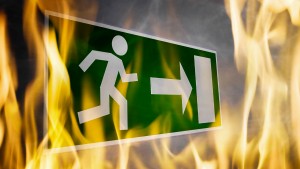Although we hope you never need it, a well-structured fire evacuation plan is an important part of your business’ Fire Risk Assessment (FRA). A seamless evacuation process is not just a requirement under The Regulatory Reform (Fire Saftey) Order 2005, it is essential for ensuring your employees fully understand their roles and responsibilities should the worst happen.
Does your business have a fire evacuation plan? If the answer is yes, do you actually know what it is?
Here are 10 points that your plan should cover, or you should be considering in a plan update…
-
Make sure all employees know what to do if they discover a fire
This includes…
- Alerting the building by activating the nearest alarm call-point
- If trained and it’s safe to do so, tackling the fire with available extinguishers
-
Make sure EVERYONE is aware of the situation
- Consider the needs of people who have hearing/visual impairments because they will need extra assistance
- Will the call-point alert them? If not, make sure other employees warn them and assist them with the rest of the fire evacuation procedure – if necessary
Did you know that more than 1 in 10 employees DON’T know where their fire assembly point it?
- Make sure everyone is clear on where to go
- Ensure that all employees leave the building using their nearest, but, above all, their safest, exit
- Your designated Fire Marshal(s) should sweep the premises to check everyone has evacuated
-
Identify your escape routes
- Make sure exit doors that are to be used as escape routes are clearly highlighted with signs
- Make sure there are no obstructions to these exits
-
Store your equipment sensibly
- Fire Fighting equipment should be stored in common areas of the building and also nearby to fire exit doors
- Make sure all your employees are aware that only the designated Fire Marshals or trained individuals are permitted to use fire extinguishers
-
Are your employees aware of their duties?
- If you have visitors or customers on-site during a fire evacuation, your employees need to understand that they are responsible for ensuring they are escorted out of the building and to the designated assembly point
- Make sure your employers are confident in doing the above procedure
- Make sure your Fire Marshals are on top of their duties. These duties could be things like contacting the fire brigade, checking windows are closed, conducting a role call to ensure everyone is out of the building and many more.
-
Have you covered all bases?
- Make sure clear arrangements are in place for the safe evacuation of people deemed to be at greater risk i.e. young persons, people with disabilities, contractors etc
-
Who calls 999?
- Make a clear decision on who is responsible for calling the fire brigade and other services if necessary
- Have a back-up option of who will fulfil this duty, should the designated person be absent on the day. Similarly, make sure this individual is confident with taking on this responsibility if required
-
When the fire brigade arrive…
- You should have a procedure in place for the sole reason that everyone knows their role once the fire brigade arrives
- Your Fire Marshal should notify the fire brigade of any specific risk when they arrive e.g. the location of highly flammable materials
-
Keep on top of your training
For your fire evacuation plan to be effective, make sure…
- Run annual fire drills for all employees
- Give all employees annual fire briefing
- Keep records and annually review everyone’s training
- Provide the Fire Marshal with sufficient training


